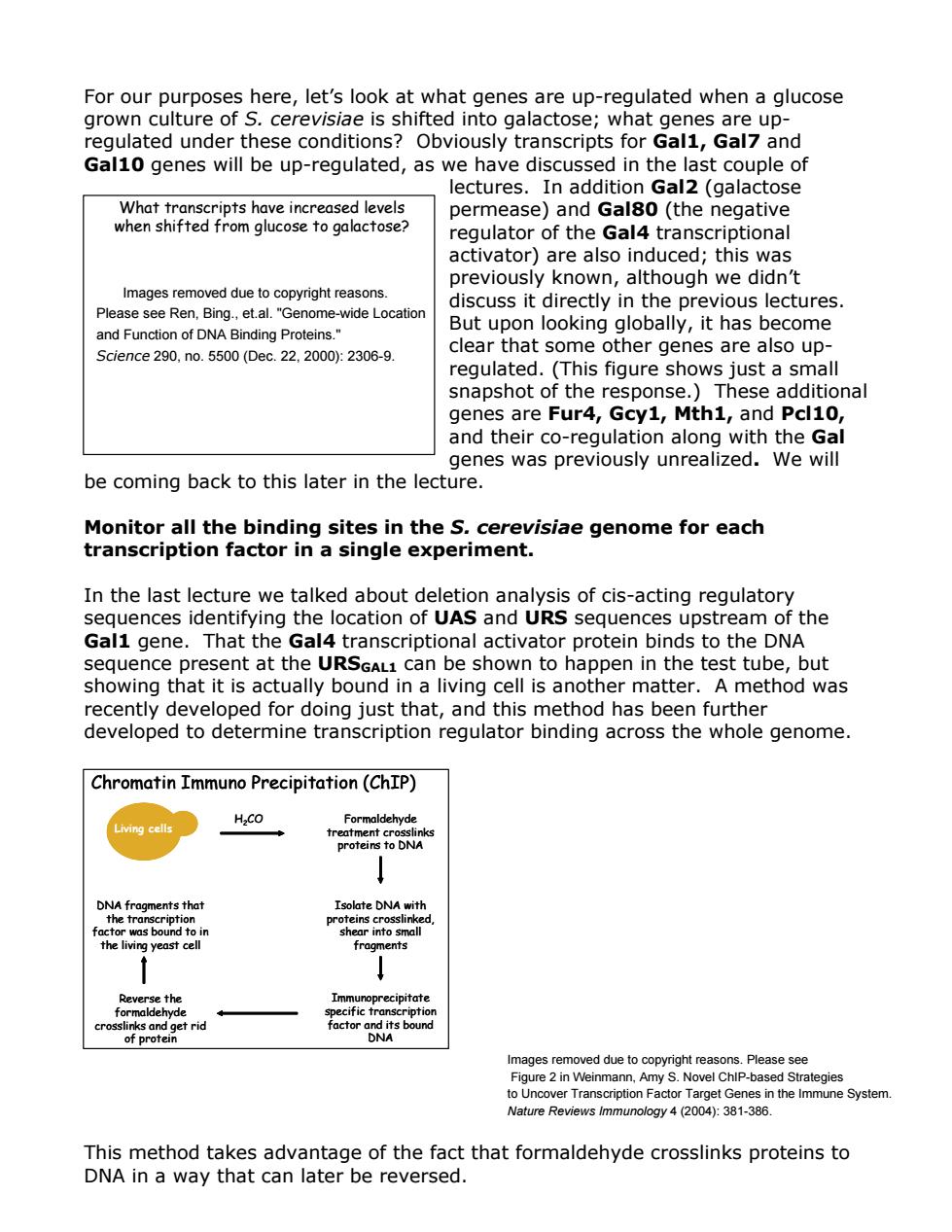正在加载图片...

For our purposes here,let's look at what genes are up-regulated when a glucose grown culture of S.cerevisiae is shifted into galactose;what genes are up- regulated under these conditions?Obviously transcripts for Gal1,Gal7 and Gal10 genes will be up-regulated,as we have discussed in the last couple of lectures.In addition Gal2(galactose What transcripts have increased levels permease)and Gal80(the negative when shifted from glucose to galactose? regulator of the Gal4 transcriptional activator)are also induced;this was previously known,although we didn't Images removed due to copyright reasons. discuss it directly in the previous lectures. Please see Ren,Bing.,et.al."Genome-wide Location and Function of DNA Binding Proteins." But upon looking globally,it has become Science290,no.5500(Dec.22,2000):2306-9. clear that some other genes are also up- regulated.(This figure shows just a small snapshot of the response.These additional genes are Fur4,Gcy1,Mth1,and Pcl10, and their co-regulation along with the Gal genes was previously unrealized.We will be coming back to this later in the lecture. Monitor all the binding sites in the S.cerevisiae genome for each transcription factor in a single experiment. In the last lecture we talked about deletion analysis of cis-acting regulatory sequences identifying the location of UAS and URS sequences upstream of the Gal1 gene.That the Gal4 transcriptional activator protein binds to the DNA sequence present at the URSGAL1 can be shown to happen in the test tube,but showing that it is actually bound in a living cell is another matter.A method was recently developed for doing just that,and this method has been further developed to determine transcription regulator binding across the whole genome. Chromatin Immuno Precipitation(ChIP) H.CO Formaldehyde Living cells treatment crosslinks proteins to DNA DNA fragments that Isolate DNA with the transcription proteins crosslinked, factor was bound to in shear into small the living yeast cell fragments Reverse the Immunoprecipitate formaldehyde specific transcription crosslinks and get rid factor and its bound of protein DNA Images removed due to copyright reasons.Please see Figure 2 in Weinmann,Amy S.Novel ChlP-based Strategies to Uncover Transcription Factor Target Genes in the Immune System. Nature Reviews Immunology 4(2004):381-386. This method takes advantage of the fact that formaldehyde crosslinks proteins to DNA in a way that can later be reversed.For our purposes here, let’s look at what genes are up-regulated when a glucose grown culture of S. cerevisiae is shifted into galactose; what genes are upregulated under these conditions? Obviously transcripts for Gal1, Gal7 and Gal10 genes will be up-regulated, as we have discussed in the last couple of lectures. In addition Gal2 (galactose permease) and Gal80 (the negative regulator of the Gal4 transcriptional activator) are also induced; this was previously known, although we didn’t discuss it directly in the previous lectures. But upon looking globally, it has become clear that some other genes are also upregulated. (This figure shows just a small snapshot of the response.) These additional genes are Fur4, Gcy1, Mth1, and Pcl10, and their co-regulation along with the Gal genes was previously unrealized. We will be coming back to this later in the lecture. What transcripts have increased levels when shifted from glucose to galactose? Monitor all the binding sites in the S. cerevisiae genome for each transcription factor in a single experiment. In the last lecture we talked about deletion analysis of cis-acting regulatory sequences identifying the location of UAS and URS sequences upstream of the Gal1 gene. That the Gal4 transcriptional activator protein binds to the DNA sequence present at the URSGAL1 can be shown to happen in the test tube, but showing that it is actually bound in a living cell is another matter. A method was recently developed for doing just that, and this method has been further developed to determine transcription regulator binding across the whole genome. Chromatin Immuno Precipitation (ChIP) Formaldehyde treatment crosslinks proteins to DNA Isolate DNA with proteins crosslinked, shear into small fragments Immunoprecipitate specific transcription factor and its bound DNA Reverse the formaldehyde crosslinks and get rid of protein DNA fragments that the transcription factor was bound to in the living yeast cell Living cells H2CO Chromatin Immuno Precipitation (ChIP) Formaldehyde treatment crosslinks proteins to DNA Isolate DNA with proteins crosslinked, shear into small fragments Immunoprecipitate specific transcription factor and its bound DNA Reverse the formaldehyde crosslinks and get rid of protein DNA fragments that the transcription factor was bound to in the living yeast cell Living cells H2CO This method takes advantage of the fact that formaldehyde crosslinks proteins to DNA in a way that can later be reversed. Images removed due to copyright reasons. Please see Ren, Bing., et.al. "Genome-wide Location and Function of DNA Binding Proteins." Science 290, no. 5500 (Dec. 22, 2000): 2306-9. Images removed due to copyright reasons. Please see Figure 2 in Weinmann, Amy S. Novel ChIP-based Strategies to Uncover Transcription Factor Target Genes in the Immune System. Nature Reviews Immunology 4 (2004): 381-386